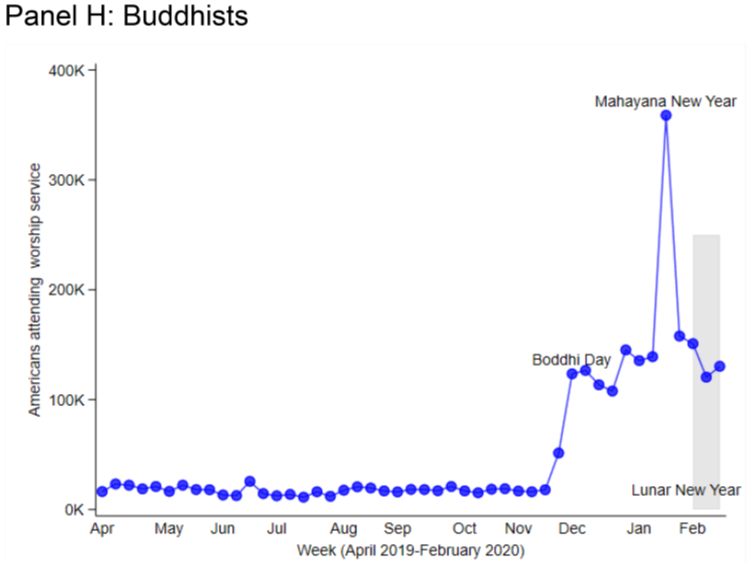Part 2 – Religion in America: Evidence from Cellphone Data
Based on the 2.1M cellphones in my main sample that I discussed in “Part 1”, here is the estimated number of worshippers in the US each week from April 2019 to Feb 2020:
Based on the 2.1M cellphones in my main sample that I discussed in “Part 1”, here is the estimated number of worshippers in the US each week from April 2019 to Feb 2020:

~30 million Americans attend a worship service each week. Attendance increases by ~50% for Easter and Christmas. There are dips in attendance on holiday weekends.
In the next 8 figures, I show attendance separately for the 8 largest religions (using Pew's classification).
In the next 8 figures, I show attendance separately for the 8 largest religions (using Pew's classification).
Latter-day Saints (Mormons): ~1.4M in attendance each week. 2 large drops for online conferences. No spikes in attendance for Easter or Christmas. 

Jews: ~150k in attendance each week. Large spikes for 4 major holidays. Note: these estimates are an undercount to the extent that many Jews (e.g. Orthodox) will not have cellphones on Shabat. 

Muslims: ~100k in attendance each week. Large increase in attendance during Ramadan ending with Eid al-Fitr and also a spike for Eid al-Adha. 

Buddhists: ~20k in attendance each week for most of year. Large increase starting with Bodhi Day and continuing through the Lunar New Year. (My Buddhist network is limited – feedback about whether this seems reasonable from those that know would be helpful!) 

These figures show how cellphone data can be used to create estimates for week-to-week attendance in the US as a whole and week-to-week attendance for a particular religion, measures that are *very* hard to find through traditional data sources.
@Michael77285783 It is also possible that many super old people don’t have smartphones. This would be a bit of a bias in the opposite direction. So the kid bias vs the old people bias might cancel out a bit making our estimates about right overall.
• • •
Missing some Tweet in this thread? You can try to
force a refresh
















